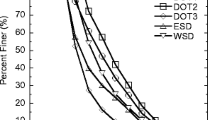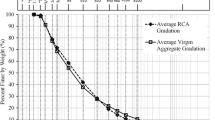Abstract
Chemicals leached from concrete are an important way that urban stormwater can influence water quality. In this study, we evaluated the weathering properties of sidewalk samples and tested how carbonation (exposure to elevated levels of gaseous CO2) can be used to simulate natural aging of concrete. The experiments focused on acid neutralizing capacity (ANC), which is known to be released by concrete in large amounts, and Cr(VI), because of its established carcinogenicity and prevalence in concrete. Chemical weathering of crushed sidewalk samples was measured with upflow recirculating columns carrying simulated acid rain. The weathering rate of ANC from four different samples was found to decrease after 1 week of exposure to a 5% carbon dioxide atmosphere and to remain constant thereafter through 8 weeks of carbonation treatment. In contrast, weathering of chromium (VI) increased after exposure to a 5% carbon dioxide atmosphere for 1 week, though it also remained stable from then through 8 weeks of carbonation. Almost all ions approached steady state after 2.5 h in the recirculation columns irrespective of carbonation time. The main contributor of ANC was Ca2+ ion, though this was partly balanced by an unexpectedly high amount of SO42−. A notable exception to the temporal leaching pattern was largely un-ionized Si, which continued to increase in concentration for at least 3 days of recirculation. Si levels were also higher than is generally observed for aluminosilicate weathering in small watersheds, a novel finding.






Similar content being viewed by others
References
Arakaki, T., & Mucci, A. (1995). A continuous and mechanistic representation of calcite reaction-controlled kinetics in dilute solutions at 25 degrees C and 1 atm total pressure. Aquatic Geochemistry, 1, 105–130.
Baker, A., Cumberland, S., & Hudson, N. (2008). Dissolved and total organic and inorganic carbon in some British rivers. Area, 40, 117–127.
Bodaghpour, S., Joob, N. B., & Ahmadib, S. (2012). A review on the existence of chrome in cement and environmental remedies to control its effects. International Journal of Geology, 6, 62–67.
Brogren, C., & Karlsson, H. T. (1997). A model for prediction of limestone dissolution in wet flue gas desulfurization applications. Industrial & Engineering Chemistry Research, 36, 3889–3897.
Busenberg, E., & Plummer, L. N. (1982). The kinetics of dissolution of dolomite in CO2-H2O systems at 1.5 to 65 degrees C and 0 to 1 atm pCO2. American Journal of Science, 282, 45–78.
Chen, Q. Y., Tyrer, M., Hills, C. D., Yang, X. M., & Carey, P. (2009). Immobilisation of heavy metal in cement-based solidification/stabilisation: a review. Waste Management, 29, 390–403.
Connor, N. P., Sarraino, S., Frantz, D. E., Bushaw-Newton, K., & MacAvoy, S. E. (2014). Geochemical characteristics of an urban river: influences of an anthropogenic landscape. Applied Geochemistry, 47, 209–216.
Dayal, R., & Reardon, E. J. (1994). Carbon-14 behaviour in a cement-dominated environment: implications for spent CANDU resin waste disposal. Waste Management, 14, 457–466.
Dreybrodt, W., Lauckner, J., Zaihua, L., & Svensson, B. (1996). The kinetics of the reaction CO2 + H2O → HCO3 − as one of the rate-limiting steps for the dissolution of calcite in the system H2O–CO2–CaCO3. Geochimica et Cosmochimica Acta, 60, 3375–3381.
Duguid, A., & Scherer, G. W. (2010). Degradation of oilwell cement due to exposure to carbonated brine. International Journal of Greenhouse Gas Control, 4, 546–560.
Eisenlohr, L., Meteva, K., Gabrovšek, F., & Dreybrodt, W. (1999). The inhibiting action of intrinsic impurities in natural calcium carbonate minerals to their dissolution kinetics in aqueous H2O–CO2 solutions. Geochimica et Cosmochimica Acta, 63, 989–1001.
Engelsen, C. J., van der Sloot, H. A., Wibetoe, G., Petkovic, G., Stoltenberg-Hansson, E., & Lund, W. (2009). Release of major elements from recycled concrete aggregates and geochemical modelling. Cement and Concrete Research, 39, 446–459.
Espinosa, D. C. R., & Tenório, J. A. S. (2000). Laboratory study of galvanic sludge’s influence on the clinkerization process. Resources, Conservation and Recycling, 31, 71–82.
Groves, G., Rodway, D., & Richardson, I. G. (1990). The carbonation of hardened cement pastes. Advances in Cement Research, 3, 117–125.
Herlihy, A. T., Stoddard, J. L., & Johnson, C. B. (1998). The relationship between stream chemistry and watershed land cover data in the mid-Atlantic region, US. Water Air and Soil Pollution, 105, 377–386.
Hills, L. M., & Johansen, V. C. (2007). Hexavalent chromium in cement manufacturing: literature review. Skokie: Portland Cement Association.
Hyvert, N., Sellier, A., Duprat, F., Rougeau, P., & Francisco, P. (2010). Dependency of C-S-H carbonation rate on CO2 pressure to explain transition from accelerated tests to natural carbonation. Cement and Concrete Research, 40, 1582–1589.
John, D. A. S., Poole, A. B., & Sims, I. (1998). Concrete petrography: a handbook of investigative techniques. London: Arnold.
Kayhanian, M., Vichare, A., Green, P. G., & Harvey, J. (2009). Leachability of dissolved chromium in asphalt and concrete surfacing materials. Journal of Environmental Management, 90, 3574–3580.
Lancia, A., Musmarra, D., & Pepe, F. (1997). Mass transfer between a fixed bed of limestone particles and acid solutions. Industrial & Engineering Chemistry Research, 36, 3859–3865.
Leisinger, S. M., Bhatnagar, A., Lothenbach, B., & Johnson, C. A. (2014). Solubility of chromate in a hydrated OPC. Applied Geochemistry, 48, 132–140.
Luquot, L., Abdoulghafour, H., & Gouze, P. (2013). Hydro-dynamically controlled alteration of fractured Portland cements flowed by CO2-rich brine. International Journal of Greenhouse Gas Control, 16, 167–179.
McNeill, L. S., McLean, J. E., Parks, J. L., & Edwards, M. (2012). Hexavalent chromium review, part 2: chemistry, occurrence, and treatment. Journal American Water Works Association, 104, 39–40.
Müllauer, W., Beddoe, R. E., & Heinz, D. (2012). Effect of carbonation, chloride and external sulphates on the leaching behaviour of major and trace elements from concrete. Cement and Concrete Composites, 34, 618–626.
National Atmospheric Deposition Program (2010). NADP map viewer. Champaign: NADP Program Office, Illinois State Water Survey.
Neves, R., Branco, F., & De Brito, J. (2013). Field assessment of the relationship between natural and accelerated concrete carbonation resistance. Cement and Concrete Composites, 41, 9–15.
Noiriel, C., Luquot, L., Madé, B., Raimbault, L., Gouze, P., & Van Der Lee, J. (2009). Changes in reactive surface area during limestone dissolution: an experimental and modelling study. Chemical Geology, 265, 160–170.
Pepe, F. (2001). Dissolution of finely ground limestone particles in acidic solutions. Industrial & Engineering Chemistry Research, 40, 5378–5385.
Plummer, L. N., & Wigley, T. M. L. (1976). The dissolution of calcite in CO2-saturated solutions at 25° C and 1 atmosphere total pressure. Geochimica et Cosmochimica Acta, 40, 191–202.
Plummer, L. N., Wigley, T. M. L., & Parkhurst, D. L. (1978). The kinetics of calcite dissolution in CO2-water systems at 5 degrees to 60 degrees C and 0.0 to 1.0 atm CO2. American Journal of Science, 278, 179–216.
Pu, Q., Jiang, L. H., Xu, J. X., Chu, H. Q., Xu, Y., & Zhang, Y. (2012). Evolution of pH and chemical composition of pore solution in carbonated concrete. Construction and Building Materials, 28, 519–524.
Rauch, H. W., & White, W. B. (1977). Dissolution kinetics of carbonate rocks: 1. Effects of lithology on dissolution rate. Water Resources Research, 13, 381–394.
Reardon, E. J., & Fagan, R. (2000). The calcite/portlandite phase boundary: enhanced calcite solubility at high pH. Applied Geochemistry, 15, 327–335.
Schiopu, N., Tiruta-Barna, L., Jayr, E., Mehu, J., & Moszkowicz, P. (2009). Modelling and simulation of concrete leaching under outdoor exposure conditions. Science of the Total Environment, 407, 1613–1630.
Sinyoung, S., Asavapisit, S., Kajitvichyanukul, P., & Songsiriritthigul, P. (2011a). Speciation of Cr in cement clinkers obtained from co-burning with Cr2O3. Nuclear Instruments & Methods in Physics Research Section a-Accelerators Spectrometers Detectors and Associated Equipment, 649, 210–212.
Sinyoung, S., Songsiriritthigul, P., Asavapisit, S., & Kajitvichyanukul, P. (2011b). Chromium behavior during cement-production processes: a clinkerization, hydration, and leaching study. Journal of Hazardous Materials, 191, 296–305.
Suarez, D. L. (1983). Calcite supersaturation and precipitation kinetics in the Lower Colorado River, All-American Canal and East Highline Canal. Water Resources Research, 19, 653–661.
Ukawa, N., Takashina, T., Oshima, M., & Oishi, T. (1993). Effects of salts on limestone dissolution rate in wet limestone flue gas desulfurization. Environmental Progress, 12, 294–299.
Van Gerven, T., Cornelis, G., Vandoren, E., Vandecasteele, C., Garrabrants, A. C., Sanchez, F., & Kosson, D. S. (2006). Effects of progressive carbonation on heavy metal leaching from cement-bound waste. AICHE Journal, 52, 826–837.
Wang JG (1994) Sulfate attack on hardened cement paste. Cement and Concrete Research 24, 735–742.
Wang, S., & Vipulanadan, C. (2000). Solidification/stabilization of Cr(VI) with cement - leachability and XRD analyses. Cement and Concrete Research, 30, 385–389.
Williams, M., Hopkinson, C., Rastetter, E., Vallino, J., & Claessens, L. (2005). Relationships of land use and stream solute concentrations in the Ipswich River basin, northeastern Massachusetts. Water Air and Soil Pollution, 161, 55–74.
Author information
Authors and Affiliations
Corresponding author
Additional information
Publisher’s Note
Springer Nature remains neutral with regard to jurisdictional claims in published maps and institutional affiliations.
Rights and permissions
About this article
Cite this article
Demars, S., Benoit, G. Leaching of ANC and Chromium from Concrete: Effect of Aging Simulated by Sample Carbonation. Water Air Soil Pollut 230, 159 (2019). https://doi.org/10.1007/s11270-019-4213-y
Received:
Accepted:
Published:
DOI: https://doi.org/10.1007/s11270-019-4213-y




